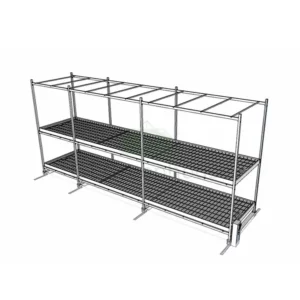Yes, grow racks have applications in both commercial and small-scale farming, offering versatile solutions for various agricultural needs. Grow racks, also known as vertical farming or mobile grow racks, are structures designed to maximize space utilization and enhance the efficiency of plant cultivation.
Here’s how grow racks are applicable in both commercial and small-scale farming:
Commercial Farming:
- High-Density Crop Production:
- In commercial farming, where space is often at a premium, grow racks enable high-density crop production. These systems allow growers to stack multiple layers of plants vertically, maximizing the use of available space in large-scale greenhouse or indoor environments.
- Year-Round Production:
- Commercial operations often require consistent and year-round production to meet market demands. Grow racks, especially when integrated with climate control systems and artificial lighting, enable continuous cultivation regardless of external weather conditions.
- Precision Agriculture:
- Grow racks in commercial settings often incorporate precision agriculture technologies, including automated irrigation, climate control, and monitoring systems. This level of precision allows for optimal resource management and crop customization to meet market specifications.
- Modular and Scalable Systems:
- Commercial farms can benefit from the modular and scalable nature of grow racks. Growers can expand or adjust their cultivation systems based on changing production needs, providing flexibility for different crops and market demands.
- Hydroponic and Aeroponic Systems:
- Grow racks are well-suited for hydroponic or aeroponic cultivation methods commonly employed in commercial farming. These systems provide efficient nutrient delivery and water management, optimizing resource use and promoting healthier plant growth.
- Labor Efficiency:
- In large-scale commercial operations, labor efficiency is crucial. Grow racks can be designed with features such as automated systems for planting, harvesting, and maintenance, reducing the need for manual labor and increasing overall operational efficiency.
- Consistent Crop Quality:
- Grow racks help maintain consistent environmental conditions for crops, resulting in uniform growth and high-quality produce. This consistency is especially important in commercial farming to meet market standards and consumer expectations.
Small-Scale Farming:
- Limited Space Utilization:
- In small-scale or urban farming scenarios, where available land may be restricted, grow racks offer a space-efficient solution. China Grow Racks supplier Vertical farming allows growers to maximize cultivation in limited areas, making it suitable for balconies, rooftops, or small greenhouse spaces.
- Ease of Setup and Maintenance:
- Grow racks are often designed to be portable and easy to set up, making them accessible for small-scale farmers with limited infrastructure. Additionally, these systems are generally easier to maintain, providing a user-friendly solution for beginners or hobbyist farmers.
- Adaptability to Indoor Spaces:
- Grow racks are suitable for indoor cultivation, making them applicable in small-scale farming scenarios where outdoor space is not available or practical. Indoor setups can be tailored to provide controlled environments for various crops.
- Crop Diversification:
- Small-scale farmers may benefit from grow racks by diversifying the types of crops they cultivate. The versatility of these systems allows growers to experiment with different plant varieties, herbs, or specialty crops to meet niche market demands.
- Reduced Environmental Impact:
- Vertical farming with grow racks can be resource-efficient, using less water and land compared to traditional farming methods. This makes them environmentally friendly and suitable for small-scale farmers aiming for sustainable and low-impact practices.
- Urban Agriculture:
- Grow racks are well-suited for urban agriculture, where space constraints are common. They allow farmers to bring cultivation into urban environments, contributing to local food production and reducing the ecological footprint associated with transporting produce over long distances.
- Educational and Community Gardens:
- In educational settings or community gardens, grow racks provide an educational platform for learning about plant cultivation. Their manageable size and adaptability make them suitable for teaching purposes or community-based agricultural initiatives.
In summary, grow racks offer practical solutions for both commercial and small-scale farming, providing flexibility, space efficiency, and adaptability to different farming needs. The specific application depends on factors such as the scale of cultivation, available space, desired crop types, and overall farming goals.
